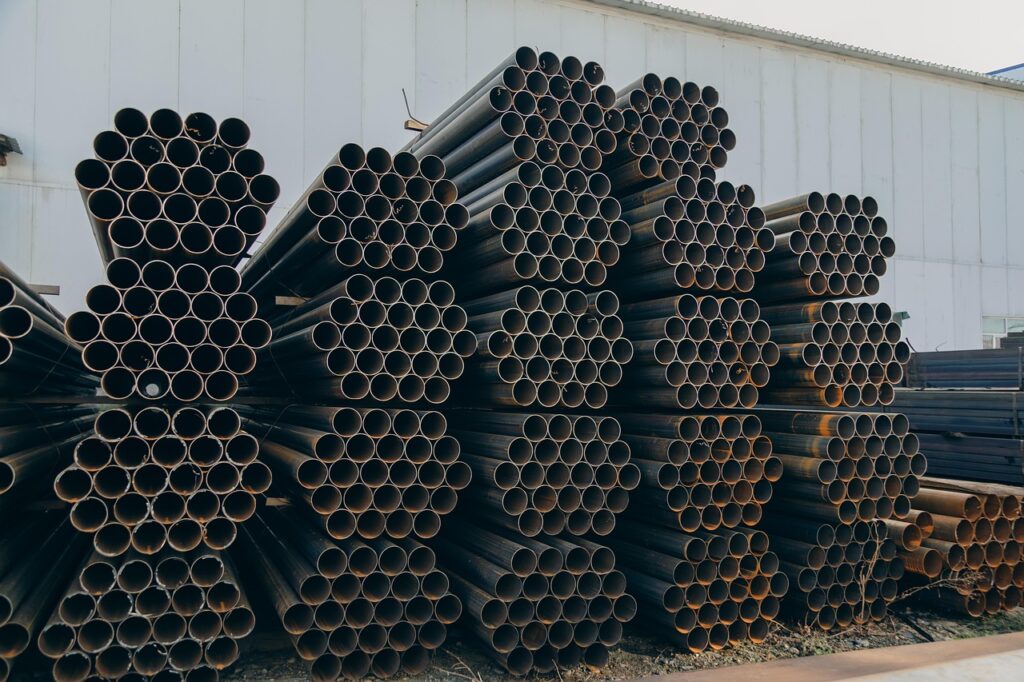Metal is an important part of modern construction and design. For fencing, gates, furniture, structural elements, and decorative pieces, two commonly considered materials are wrought iron and steel.
Both materials bring their own advantages and longevity traits to the table. When homeowners or builders make decisions about durability and lifespan, they need to examine the properties of both metals.
This article explores how wrought iron and steel compare in terms of longevity, resistance to environmental elements, maintenance needs, and practical application.
Understanding Wrought Iron and Its Composition
Wrought iron is an iron alloy with a very low carbon content. It is highly malleable and fibrous in structure. Artisans have used wrought iron for centuries because of its toughness and resistance to fatigue. It was commonly used before the advent of mild steel, especially in gates, fences, railings, and hardware. The presence of slag fibers in wrought iron gives it a distinctive grain, similar to wood. This grain helps it withstand corrosion better than some types of steel.
Traditional wrought iron is no longer mass produced. What many refer to today as wrought iron is actually mild steel that has been fabricated to look like old ironwork. However, genuine wrought iron still exists in historic buildings and restoration projects. The real material has a certain longevity rooted in its composition and the way it reacts to moisture and oxygen.
Understanding Steel and Its Versatility
Steel is made from iron and carbon, and its strength depends on the amount of carbon present. Various types of steel exist, from carbon steel to stainless steel, each with its own benefits. The presence of carbon makes steel much harder than wrought iron. The addition of elements like chromium or nickel can also improve corrosion resistance and hardness.
Steel has become the preferred material for modern construction due to its high tensile strength, availability, and lower production cost. From skyscrapers to household appliances, steel finds its place almost everywhere. Its durability is exceptional when protected correctly against the elements.
Resistance to Rust and Corrosion
One of the most important factors when comparing lifespan is how well the metal resists rust. Corrosion is the natural enemy of metal and causes degradation over time. Wrought iron contains a significant amount of slag, which actually aids in rust resistance. The fibrous slag structure within wrought iron allows it to form a protective layer of rust that slows further corrosion. Over time, this layer may stabilize, forming a patina that preserves the structure underneath.
Steel reacts differently depending on the type. Plain carbon steel can corrode rapidly if left untreated. Protective coatings such as galvanization, powder coating, or painting are essential to prevent rust. Stainless steel, which contains chromium, is far more resistant to rust. It can perform well for decades in outdoor environments if properly maintained. Steel’s performance in resisting corrosion depends heavily on its formulation and the protective measures taken during and after installation.
Strength and Durability Under Stress
Wrought iron is known for its toughness and ability to absorb shock without breaking. It is more ductile, which means it bends before it breaks. This makes it ideal for ornamental work that needs to withstand mechanical stress without snapping.
Steel, on the other hand, offers greater overall strength. It has a higher tensile strength, which means it can bear more load without deformation. Structural components made of steel are less likely to bend under pressure. In terms of sheer strength, steel outperforms wrought iron, especially in applications that demand load-bearing capacity.
Both materials can last for decades, but the intended use affects which one is a better choice. For artistic, flexible designs that require resistance to fatigue, wrought iron remains a solid option. For projects that demand strength under pressure or impact, steel is superior.
Maintenance and Longevity Over Time
Long term performance depends greatly on maintenance practices. Wrought iron, when regularly painted or treated with rust inhibitors, can last well over a hundred years. Historic fences and balconies from the nineteenth century still exist today thanks to preservation efforts. The key lies in cleaning and recoating the iron as needed.
Steel can last just as long or longer when properly protected. Galvanized steel, which is coated with a layer of zinc, provides excellent resistance to rust. Powder coated steel can resist corrosion and maintain its appearance for years. Stainless steel is extremely low maintenance and does not require painting or recoating in most environments.
Neglect can shorten the lifespan of both metals. When left exposed to rain, snow, or salt without protection, corrosion will eventually set in. However, once damaged, steel may deteriorate faster due to the absence of the self-protecting slag found in wrought iron. Regular inspection and upkeep play a crucial role in preserving the appearance and structural integrity of both metals.
Cost Versus Lifespan Considerations
Wrought iron is typically more expensive than steel. Its labor intensive manufacturing process and limited supply make it costlier to purchase and install. Custom ironwork often involves hand forging and craftsmanship, which further increases the price. However, this higher initial cost may be offset by its long lifespan and minimal replacement needs.
Steel offers a more budget friendly option and is widely available. Modern fabrication techniques allow for mass production of steel parts at relatively low cost. This makes it an attractive choice for residential and commercial projects with budget constraints. The trade off comes in the form of necessary protective treatments to ensure its longevity.
When comparing the value over decades, both materials provide excellent return on investment. The decision often comes down to the specific application, budget, and the desired aesthetic.
Aesthetic Value and Timeless Appearance
Wrought iron has a timeless charm. The intricate scrollwork and classic look appeal to those who appreciate traditional styles. It brings a sense of old world elegance and sophistication. Gates, fences, and railings made from wrought iron can serve as statement pieces that enhance curb appeal.
Steel can be shaped to mimic wrought iron designs, but it often features more modern or utilitarian styles. Powder coating allows it to come in various colors, which provides design flexibility. In contemporary architecture, clean lines and minimalist details made from steel offer a sleek and polished look.
Aesthetic preferences play a major role in selecting one over the other. For homeowners who desire intricate details and artistic flair, wrought iron is the superior choice. For those looking for a more modern or industrial appeal, steel provides versatility.
Performance in Harsh Climates
In areas prone to harsh weather, the choice of material becomes even more critical. Wrought iron holds up well in dry climates. However, in coastal areas where salt exposure is high, regular maintenance is vital to prevent rust buildup. Its porosity means that moisture can become trapped, making it more vulnerable if neglected.
Steel performs better in some extreme conditions, especially stainless or galvanized varieties. Coastal construction often favors stainless steel because of its ability to withstand salt air. Industrial and marine environments typically demand the higher corrosion resistance that steel can offer.
Selecting the appropriate protective coating or alloy type ensures long term durability. Understanding the local climate helps inform the most suitable choice between wrought iron and steel.
Environmental Impact and Sustainability
The environmental footprint of metal use is a growing concern. Wrought iron, due to its durability and low replacement rate, has a lower environmental impact over the long term. Its longevity means fewer resources are needed for repairs or replacements. Recycling wrought iron is also straightforward.
Steel has become more sustainable in recent years thanks to advancements in recycling. A large percentage of modern steel is made from recycled material. The production process still requires significant energy, but steel can be reused and repurposed multiple times without losing quality.
From an environmental perspective, both metals can be sustainable when used thoughtfully. Long term use, recyclability, and minimal waste all contribute to their eco friendly appeal.
Installation and Fabrication Differences
Working with wrought iron requires special skill. Forging and welding wrought iron is more time consuming than working with steel. Installation often involves custom fabrication on site or in a workshop. This adds to both the cost and time required to complete a project.
Steel fabrication is more standardized. Modern tools and methods allow steel to be cut, shaped, and assembled with high precision. Pre manufactured parts can be bolted or welded quickly. This efficiency makes steel an ideal material for projects with tight deadlines.
Choosing a skilled contractor with experience in the chosen material ensures quality results. The complexity of installation can influence the decision between wrought iron and steel.
Which Material Lasts Longer in Practice
Wrought iron and steel both offer remarkable longevity. In some cases, wrought iron has outlasted steel due to its resistance to fatigue and its self protective nature. Historic examples around the world provide living proof of this durability.
Steel, when protected correctly, can also last for many decades. Stainless steel installations can remain corrosion free with little maintenance. In real world applications, the performance often depends on how the material is treated and maintained rather than the metal itself.
Long term durability is achievable with either material if proper steps are taken. Regular inspections, protective coatings, and timely repairs make all the difference.
Making the Right Choice for Your Project
The final decision between wrought iron and steel depends on several factors. Design preferences, environmental conditions, budget, and maintenance commitment all play important roles. Each metal has its strengths. Wrought iron brings traditional elegance and long term resilience. Steel offers strength, cost efficiency, and modern appeal.
Consulting with a professional can help clarify the most suitable option for your specific needs. Material choice impacts not only appearance but also the performance and value of your investment over time. Taking the time to compare features and evaluate your priorities leads to a more satisfying and lasting result.

